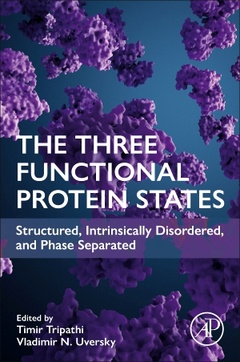The Three Functional States of Proteins Structured, Intrinsically Disordered, and Phase Separated
Coordonnateurs : Tripathi Timir, Uversky Vladimir N

Traditionally, different states of proteins have been defined based on their structures and functions. However, it is becoming increasingly clear that these criteria may not be sufficient to capture the complex properties of these molecules and that definitions based on thermodynamics and kinetics could be more appropriate. Emerging evidence indicates that under physiological conditions, most proteins can sample the native, droplet, and amyloid states. These states contribute to different cellular functions in accordance with their physical and structural properties. The native monomeric or oligomeric state of a protein is typically the most frequently observed state under cellular conditions. The biological functions of proteins are associated with this native state. Proteins in this functional state can be highly structured or intrinsically disordered (i.e., exist as highly dynamic structural ensembles of interconverting conformations), or they can combine features of order and disorder. The amyloid state with its cross-ß structure is a solid-like condensed state that is thermodynamically stable at the cellular concentrations of proteins, and therefore its formation tends to be irreversible. Although many known examples of amyloids are related to the pathogenesis of various human diseases, functional amyloids are found in all kingdoms of life. The droplet or phase-separated state is a liquid-like condensed state formed by the non-stoichiometric assembly of protein molecules, often via interaction with nucleic acids. This is the functional state of many membrane-less organelles, which are now considered major organizing elements of intracellular space. This book provides comprehensive coverage of these three protein states and their thermodynamics and kinetic properties. The book also considers their interactions and discuss how their internal organization as individual molecules and their collective organization as molecular assemblies are stabilized. It also discusses how these states are formed and examines the cellular functions associated with the specific states.
2. Ordered proteins and structure-function relationship: Classical view
3. "Lock and Key" and "Induced Fit" work at different stages of enzyme action
4. Intrinsically disordered proteins: Functionality of chaos
5. Hybrid proteins: Order and disorder join forces
6. Functional protein oligomers
7. Fuzzy complexes
8. Functional amyloids: An overview
9. Structural polymorphism of amyloids
10. Liquid-liquid phase separation, biomolecular condensates, and membrane-less organelles: A novel organizational principle of the intracellular space
11. Physical principles and molecular interactions underlying protein phase separation
12. Various levels of phase transitions in the protein universe
13. Targeting phase-separated states for drug discovery
14. Protein hydrogels
15. Interactions among the three protein states
16. Protein frustration and fuzziness in three functional states
17, Protein structure-function continuum
Vladimir N. Uversky is a Professor at the Department of Molecular Medicine, University of
South Florida, USA. He obtained B.S. and M.S. degrees in Physics from Leningrad State
University in Russia in 1986, then completed Ph.D. and Doctor of Sciences (D.Sc.) degrees
in Physics and Mathematics (field of study - Biophysics) at the Moscow Institute of Physics and Technology (1991) and the Institute Experimental and Theoretical Biophysics of the Russian Academy of Sciences (1998), respectively. In 1998, he moved to the University of California Santa Cruz to study protein folding, misfolding, protein conformation diseases, and protein intrinsic disorder phenomena. In 2004, he was invited to join the Indiana University School of Medicine to primary work on intrinsically disordered proteins, and since 2010 has been on faculty at the University of South Florida. He has authored over 850 scientific publications and edited several books and book series on protein structure.
- Contain chapters written by leading global experts actively engaged in the field of the analysis of these three functional states of proteins
- Presents a broad picture of the current, emerging, and evolving state of the protein states.
- Covers the basics of the field along with recent advancements, it is expected that it will also attract readers from diverse subject areas
Date de parution : 02-2025
Ouvrage de 450 p.
15x22.8 cm



